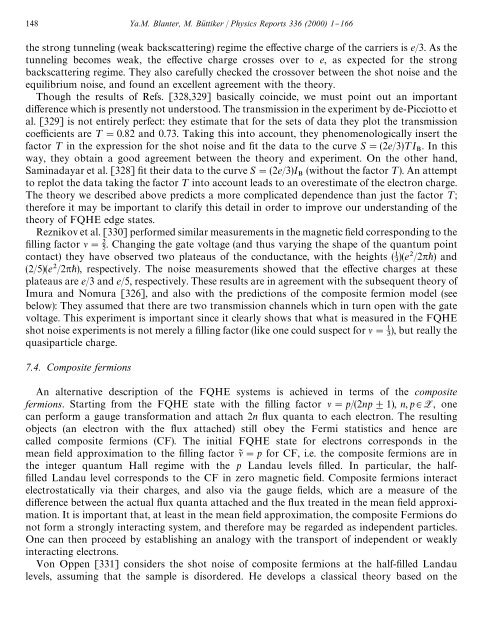shot noise in mesoscopic conductors - Low Temperature Laboratory
shot noise in mesoscopic conductors - Low Temperature Laboratory
shot noise in mesoscopic conductors - Low Temperature Laboratory
Create successful ePaper yourself
Turn your PDF publications into a flip-book with our unique Google optimized e-Paper software.
148 Ya.M. Blanter, M. Bu( ttiker / Physics Reports 336 (2000) 1}166<br />
the strong tunnel<strong>in</strong>g (weak backscatter<strong>in</strong>g) regime the e!ective charge of the carriers is e/3. As the<br />
tunnel<strong>in</strong>g becomes weak, the e!ective charge crosses over to e, as expected for the strong<br />
backscatter<strong>in</strong>g regime. They also carefully checked the crossover between the <strong>shot</strong> <strong>noise</strong> and the<br />
equilibrium <strong>noise</strong>, and found an excellent agreement with the theory.<br />
Though the results of Refs. [328,329] basically co<strong>in</strong>cide, we must po<strong>in</strong>t out an important<br />
di!erence which is presently not understood. The transmission <strong>in</strong> the experiment by de-Picciotto et<br />
al. [329] is not entirely perfect: they estimate that for the sets of data they plot the transmission<br />
coe$cients are ¹"0.82 and 0.73. Tak<strong>in</strong>g this <strong>in</strong>to account, they phenomenologically <strong>in</strong>sert the<br />
factor ¹ <strong>in</strong> the expression for the <strong>shot</strong> <strong>noise</strong> and "t the data to the curve S"(2e/3)¹I . In this<br />
way, they obta<strong>in</strong> a good agreement between the theory and experiment. On the other hand,<br />
Sam<strong>in</strong>adayar et al. [328] "t their data to the curve S"(2e/3)I (without the factor ¹). An attempt<br />
to replot the data tak<strong>in</strong>g the factor ¹ <strong>in</strong>to account leads to an overestimate of the electron charge.<br />
The theory we described above predicts a more complicated dependence than just the factor ¹;<br />
therefore it may be important to clarify this detail <strong>in</strong> order to improve our understand<strong>in</strong>g of the<br />
theory of FQHE edge states.<br />
Reznikov et al. [330] performed similar measurements <strong>in</strong> the magnetic "eld correspond<strong>in</strong>g to the<br />
"ll<strong>in</strong>g factor " . Chang<strong>in</strong>g the gate voltage (and thus vary<strong>in</strong>g the shape of the quantum po<strong>in</strong>t<br />
contact) they have observed two plateaus of the conductance, with the heights ( )(e/2) and<br />
(2/5)(e/2), respectively. The <strong>noise</strong> measurements showed that the e!ective charges at these<br />
plateaus are e/3 and e/5, respectively. These results are <strong>in</strong> agreement with the subsequent theory of<br />
Imura and Nomura [326], and also with the predictions of the composite fermion model (see<br />
below): They assumed that there are two transmission channels which <strong>in</strong> turn open with the gate<br />
voltage. This experiment is important s<strong>in</strong>ce it clearly shows that what is measured <strong>in</strong> the FQHE<br />
<strong>shot</strong> <strong>noise</strong> experiments is not merely a "ll<strong>in</strong>g factor (like one could suspect for " ), but really the<br />
quasiparticle charge.<br />
7.4. Composite fermions<br />
An alternative description of the FQHE systems is achieved <strong>in</strong> terms of the composite<br />
fermions. Start<strong>in</strong>g from the FQHE state with the "ll<strong>in</strong>g factor "p/(2np$1), n, p3Z, one<br />
can perform a gauge transformation and attach 2n #ux quanta to each electron. The result<strong>in</strong>g<br />
objects (an electron with the #ux attached) still obey the Fermi statistics and hence are<br />
called composite fermions (CF). The <strong>in</strong>itial FQHE state for electrons corresponds <strong>in</strong> the<br />
mean "eld approximation to the "ll<strong>in</strong>g factor "p for CF, i.e. the composite fermions are <strong>in</strong><br />
the <strong>in</strong>teger quantum Hall regime with the p Landau levels "lled. In particular, the half-<br />
"lled Landau level corresponds to the CF <strong>in</strong> zero magnetic "eld. Composite fermions <strong>in</strong>teract<br />
electrostatically via their charges, and also via the gauge "elds, which are a measure of the<br />
di!erence between the actual #ux quanta attached and the #ux treated <strong>in</strong> the mean "eld approximation.<br />
It is important that, at least <strong>in</strong> the mean "eld approximation, the composite Fermions do<br />
not form a strongly <strong>in</strong>teract<strong>in</strong>g system, and therefore may be regarded as <strong>in</strong>dependent particles.<br />
One can then proceed by establish<strong>in</strong>g an analogy with the transport of <strong>in</strong>dependent or weakly<br />
<strong>in</strong>teract<strong>in</strong>g electrons.<br />
Von Oppen [331] considers the <strong>shot</strong> <strong>noise</strong> of composite fermions at the half-"lled Landau<br />
levels, assum<strong>in</strong>g that the sample is disordered. He develops a classical theory based on the
















